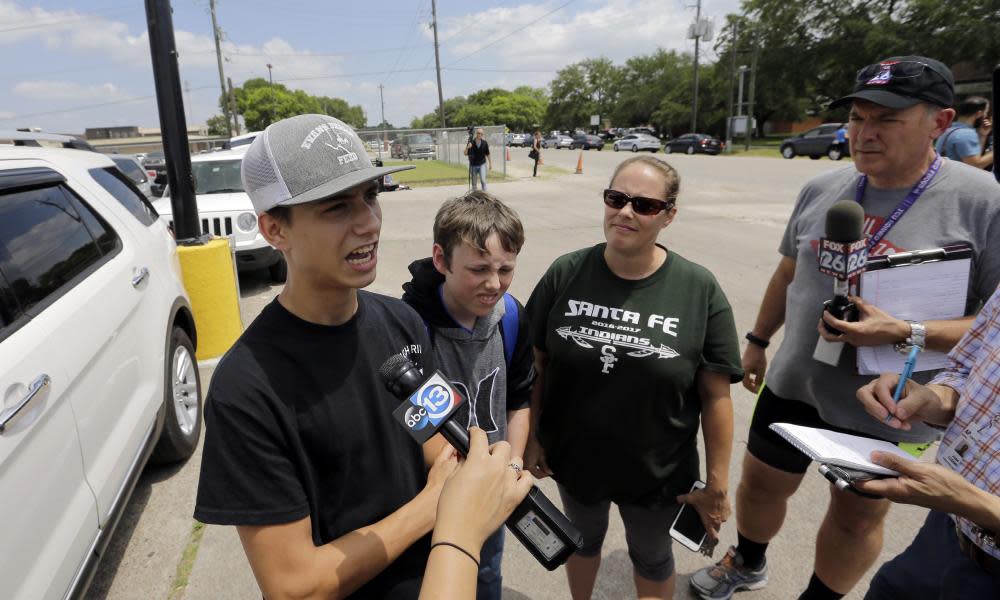'It's been happening everywhere': Santa Fe saddened but not surprised by shooting

Normally bustling on a Friday lunchtime, Pook’s Crawfish Hole was closed. Where the giant roadside sign might usually promote the restaurant’s specials, it said: “Thoughts and Prayers With Santa Fe.”
In the deserted interior, a television mounted on the wall near dangling models of crustaceans was tuned to a local news channel’s coverage of the school shooting that had unfolded that morning just a couple of miles away.
Pook’s opens from January to June, when the crawfish from Louisiana, the next door state, are fresh. But on this day it was shut. “Out of respect,” said Gregg Vicknair, the owner. A sign on the door encouraged would-be patrons to attend the candlelight vigil planned for the evening to mourn the 10 dead.
Community gatherings are the most natural and common short-term response in the aftermath of such a tragedy; what felt different from the norm in Santa Fe after the latest American school massacre was the sense that despite theshock, such events happen often enough that it would be almost naive to experience disbelief. Even for some children, it seems, it has become a matter of not if, but when and where.
A television journalist’s interview with one Santa Fe student, Paige Curry, went viral on social media. “Was there a part of you that was like, ‘This isn’t real, this would not happen in my school?’” the reporter asked her.
Curry gave a rueful semi-laugh. “No, there wasn’t,” she replied. “It’s been happening everywhere, I’ve always kind of felt like eventually it was going to happen here too.”
Interviewer: “Was there a part of you that was like, ‘This could not happen at my school?’”
Santa Fe High School student: “No. It’s been happening everywhere. I’ve always felt it would eventually happen here, too.”pic.twitter.com/MPxVScd3QE— Shannon Watts (@shannonrwatts) May 18, 2018
Vicknair had a similar reply to a similar question: you never think it’ll happen here, right? “People say that, but I always … ” He paused. “Yes. I think that kind of stuff can happen anywhere.”
The father of three added: “It makes you wonder. Like I hear people say all the time, [school is] supposed to be a safe place. But I guess nowadays it’s just not.”
Santa Fe high school had been placed on lockdown in response to a potential threat as recently as 28 February, when police were called after reports of popping sounds.
The deaths and injuries in Santa Fe happened three months after 17 students and staff were shot dead at a high school in Parkland, Florida, generating an immense amount of activism and attention, but has not so far translated into meaningful political action.
On Friday night, several hundred people, many wearing the green colours of the high school’s sports teams, attended a vigil for the victims in the town. The event featured prayers led by local pastors and speeches by Ted Cruz, the US senator from Texas, and the governor, Greg Abbott, who told the crowd that Texas politicians would work to find solutions that return “normalcy” and “safety” to schools.
This was the 16th shooting this year at a school during school hours that caused injury or death. Combined, the tally of the previous fifteen incidents is 21 deaths and 46 injuries.

“It’s just a shame and hopefully there will be changes nationwide to secure these schools. I’ll leave that up to the professionals,” Vicknair, 39, said. “I think we’ve got officials and stuff that can make those decisions.”
Not yet swallowed by Houston’s ever-expanding suburbia, Santa Fe is a spread-out place of about 13,000 people with quiet streets lined with single-storey ranch-style houses, some with front lawns as big as basketball courts.
Less racially diverse than other parts of Texas – a large majority of residents are white – and with a slightly higher average household income than the state as a whole, it has a semi-rural character. Still, with the busy Highway 6 running through the centre of town (and past the scene of the slaughter) it is easy enough for residents to commute to Houston, the Gulf coast seaside resort of Galveston or the oil refineries and chemical plants of Texas City.
Until now, it was perhaps best known for a case in 2000 in which the US supreme court ruled that the school district’s policy of allowing student-led prayers before football games was unconstitutional.
Raymond Doreck’s family has run a meat market in the town for 45 years. His daughter attends courses at the high school but was not there on Friday.
As images from rolling news reports flickered on the computer monitor on his desk, he confronted what he fears is a modern reality with no easy solution. “You have to look at it that it could happen anywhere. You just hope that it doesn’t. I don’t know how to stop it and I don’t think gun control’s the answer,” the 56-year-old said in his small office, around the corner from a preparation room where trays of spicy beef jerky were stacked high.
“We grew up having guns, hunting, none of that ever happened when we had guns. We went to school, used to have guns in the back of our pickups, on the racks. Long as you didn’t take them inside, you know? Nothing like that ever happened.”
Outside the front entrance, at a flagpole next to a life-sized model of a cow, a man lowered the Stars and Stripes to half-staff.

 Yahoo News
Yahoo News 
